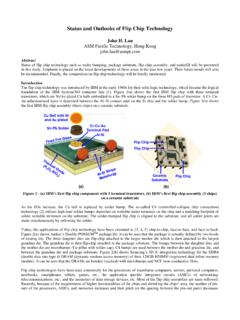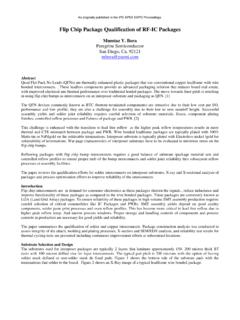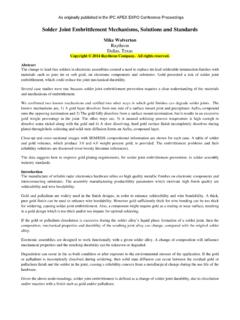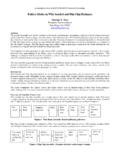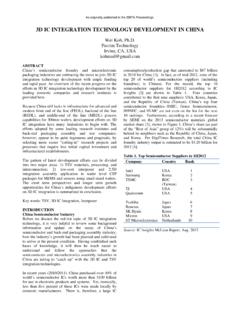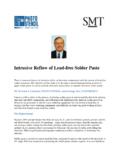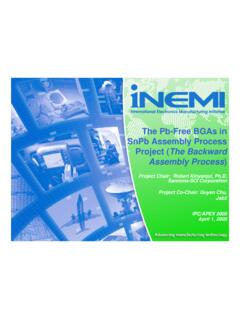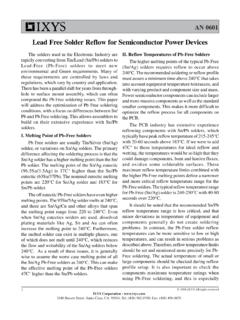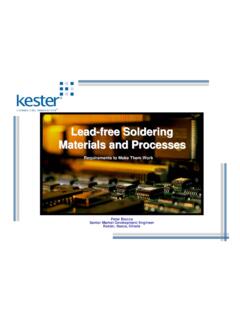Transcription of BEST PRACTICES REFLOW PROFILING FOR LEAD-FREE SMT …
1 best PRACTICES REFLOW PROFILING FOR LEAD-FREE SMT ASSEMBLY Ed Briggs Indium Corporation Clinton, NY, USA Ron Lasky, , PE Indium Corporation and Dartmouth College Clinton, NY, USA ABSTRACT The combination of higher LEAD-FREE process temperatures, smaller print deposits, and temperature restraints on electrical components has created difficult challenges in optimizing the REFLOW process. Not only are the electronic components and the PWB at risk, but the ability to achieve a robust solder joint becomes difficult, especially if the PCB is thermally massive. In addition, the constant miniaturization of electronic components, hence smaller solder paste deposits, may require the use of smaller particle-sized powders. Both the small solder paste deposits and small particle size result in a large surface area-to-volume ratio that challenges the solder paste s flux to effectively perform its fluxing action.
2 The possible resulting surface oxidation can lead to voiding, graping, head-in-pillow, and other defects. Smaller components are also more susceptible to tombstoning and defects related to solder paste slump. This paper is a summary of best PRACTICES in optimizing the REFLOW process to meet these challenges of higher REFLOW temperatures, smaller print deposits, decreased powder particle size, and their affect on the REFLOW process. It also discusses trouble-shooting of the most common defects in LEAD-FREE REFLOW , such as tombstoning, solder beading/balling, residue discoloration, voiding, graping, and head in pillow. Key words: solder defects, REFLOW profile, tombstone, solder beads, solder balls, voids, head-in-pillow, graping. INTRODUCTION The introduction of higher LEAD-FREE process temperatures and a reduction in solder paste deposit volumes require narrower process windows to optimize the REFLOW profile.
3 Not only are the electronics components and the PWB at risk due to the higher REFLOW temperatures associated with LEAD-FREE processes, the components themselves can restrict the peak temperature that the process can use, making it difficult to achieve a robust solder joint, especially if the PCB is thermally massive. Decreased pad size might also require the solder paste to have solder powder with smaller particle diameters. Both the small solder paste deposits and smaller particle size result in a large surface area to volume ratio that challenges the solder paste s flux to effectively perform its fluxing action. The resulting surface oxide can lead to a number of solder defects such as voiding, beading/balling, graping, and head-in-pillow. This paper will discuss techniques to optimize the REFLOW profile to minimize such defects.
4 TYPES OF PROFILES The two most common types of REFLOW profiles are the ramp-to-peak profile, also called ramp-to-spike or tent profile (see Figure 1) and the soak profile, or ramp/soak/spike profile (see Figure 2). A ramp-to-peak profile is a linear ramp to the peak (max) temperature. A soak profile displays some plateau within a limited temperature range, before the alloy reflows. Figure 1 - Ramp-to-peak REFLOW profile. Figure 2 - Ramp/soak/spike REFLOW profile. phases r regions: preheat, pre- REFLOW , REFLOW , and cooling. PROFILE STAGES The SMT REFLOW profile can be broken down into 4o As originally published in the SMTA International Conference The preheat phase preconditions the PCB assembly prior to actual REFLOW , removing flux volatiles and reducing thermal ock to the PCB assembly. rtant is the average ramp rate, hich is te to the average ramp rate.
5 78 C/second). ste itself, reparing the surfaces to be joined during REFLOW . profile is sually helpful to achieve successful assembly. ze of voids entrapped in the solder joint upon ooling. l bond through the formation of n-copper intermetallics. ly 30-90 seconds in order to form effective termetallics. to use the st heating zone(s), if the oven is large enough. OLUBLE VS. NO-CLEAN solder -soluble solder paste, defects such as de-wetting can ccur. e apability of the flux to provide an acceptable solder joint. sh The ramp rate is the slope of temperature versus time for the heating portion of the REFLOW profile. It originates at ambient temperature and ends at the peak temperature. The rate is defined primarily in the preheat phase. A ramp rate of C/second is normal and is largely affected by the REFLOW oven belt speed and the -T (delta-T) between heating zones ( T of <40 C is recommended between heating zones).
6 Typically the instantaneous ramp rate will vary as seen in Figure 3. Hence, the maximum ramp rate of , reported in Figure 3, is somewhat meaningless. Most impow Figure 3 - Note that the maximum slope ( C/second) does not equa(0 Pre- REFLOW At the pre- REFLOW phase, the flux activator (or activator package) removes any existing surface oxide from the component leads and PWB pad finishes, as well as any oxide on the powder particles within the solder pap A temperature soak, if incorporated, is normally found in this phase. The soak temperature is controlled within a tight range (see Figure 2) for a specified time. This plateau in the REFLOW profile allows the thermal gradient across the PCB to equilibrate prior to REFLOW . In this way, the entire assembly sees nearly the same REFLOW conditions (peak temperature and time-above-liquidus) to form consistent solder bonds.)
7 Any potential thermal gradient increases as the physical size of the PCB and the diversity of component size increase, so for such large PCBs a soaku Soak profiles are also used to minimize voiding when assembling such components as BGA (ball grid array), LGA (land grid array), SGA ( solder grid array), and QFN (quad flat pack, no leads), purging the solder paste of volatile materials, decreasing flux out-gassing, and diminishing the amount/sic REFLOW The actual REFLOW of the solder alloy involves the creation of a mechanical and electricati In forming optimum intermetallics, two critical parameters are involved in the REFLOW phase: peak temperature and TAL (time-above-liquidus). The peak temperature is generally 20-30 C above the liquidus temperature of the alloy and the TAL is typicalin Cooling The cooling phase determines the grain structure of the solder joint.
8 A fine grain structure provides the most reliable mechanical bond. To achieve this structure, a rapid cooling rate as the solder transitions from liquid (liquidus) to solid (solidus) is needed (the first ~50 C of cooling). The limiting factor for the maximum cooling rate is the stress that is exerted on the solder joint if the rate is too fast. This thermal stress, depending on the differences in CTE (coefficient of thermal expansion) of the joining surfaces, can fracture or tear the solder joint. The greater the difference in CTE of the joining materials and the cooling rate, the greater the thermal stress generated. A cooling rate of ~4 C/second is normal. Unfortunately, many ovens lack controls for the cooling zone(s). One method to overcome this isla WATER-SPASTES At this point, it may be worth discussing the fact that there are distinct differences between water-soluble and no-clean solder paste chemistries and their sensitivity to a soak or a long (total time in oven) type profile.
9 For both types of solder paste, the activator portion of the flux chemistry removes existing surface oxides on the mating surfaces, as well as the powder particles within the solder paste itself. Once removed, other flux chemistry constituents must protect the surfaces from re-oxidation. No-clean chemistries are generally rosin/resin-based materials. Rosins/resins make excellent oxide barriers and protect the cleaned surfaces during REFLOW from re-oxidation. Water-soluble fluxes, on the other hand, contain high molecular weight compounds, such as polymers, which are not as effective as rosins/resins at preventing re-oxidation. Therefore, water-soluble chemistries do not hold up well in elongated REFLOW profiles, such as soak profiles. If such profiles are used with a watero POWDER PARTICLE SIZE Particle size also affects the sensitivity of the solder paste to the REFLOW profile.
10 As the particle size decreases, the overall area of the surface exposed to oxidation increases. Increased surface oxide challenges the solder paste flux. Under these circumstances, a soak profile especially challenges thc As originally published in the SMTA International Conference The focus of this paper is the effect of REFLOW PROFILING on solder defects. Very often there are more effective and efficient methods of resolving solder defects than optimizing the REFLOW profile. For instance, it is widely accepted that 60-70% of all solder defects can be traced back to the printer. With that said, there are certainly instances where fine tuning the REFLOW profile will benefit. Also note that changing the REFLOW profile can cause other lder defects. igure 4 - An example of tombstoning. or trace, or shadowing from large adjacent omponents.

